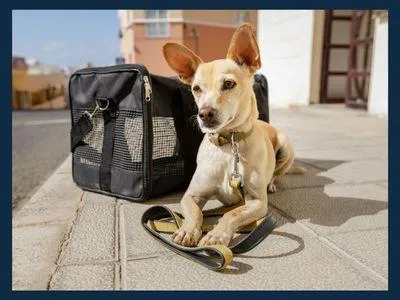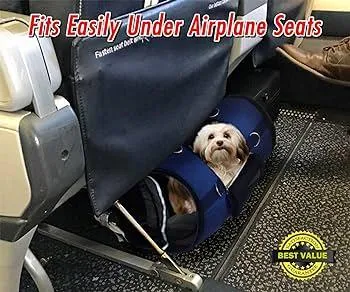Choosing the Right-Sized Pet Carrier for Travel by Air
If you’re planning to take your furry companion on a plane ride, one of the most important decisions is selecting a pet carrier that meets airline size regulations. From my experiences traveling with cats and dogs, finding the right size carrier can be tricky but is crucial for a stress-free journey. In this article, I’ll break down airline policies, recommended carrier dimensions, and real-life examples to help you pick out a carrier that fits safely under the seat.
Understanding Airline Size Restrictions
All major airlines in the US limit pet carriers to a maximum size that can fit under the seat in front of you. This is both for the animal’s safety during takeoff and landing, as well as allowing flight attendants easy access to the aisles. However, carrier size regulations can vary between carriers.
Most allow sizes up to 18 inches long x 13 inches wide x 9 inches tall. Smaller than that is generally fine, but any larger may result in a hefty fee or denied boarding. It’s important to double check size policies for your specific airline before purchasing a carrier or arriving at the airport. You can usually find them clearly listed on the carrier’s website.
Choosing the Appropriately Sized Carrier
When selecting a carrier, it’s key to realistically evaluate your pet’s dimensions and pick one just large enough for comfortable standing, turning, and lying down space. Going too small can cause stress; too big may not comply with regulations. Here are some general size guidelines based on pet type:

- Cats and small dogs under 10 lbs: 10x13x7 inches or smaller soft-sided carriers work well.
- Medium dogs 10-30 lbs: A 13x15x9 inch hard plastic or metal carrier provides necessary space.
- Large dogs 30-70 lbs: Look for carriers maxing out 16x17x12 inches to allow for sitting up comfortably.
I’d also recommend trying the actual carrier out at home before your trip. See how much room your pet seems content in and if it has enough space to turn around. A test drive will give you peace of mind at the airport that your furry friend fits safety regulations.
Real-Life Examples
Here are a couple stories from my experiences flying with pets that illustrate the importance of size:
Last year, I flew cross-country with my cat Ms. Mittens in a 13x10x8 inch soft-sided carrier. During a layover, an attendant measured it and said it was just barely under limits. Any bigger and I may have faced extra fees. Ms. Mittens seemed happy in the snug carrier.
However, when flying home with my friends’ 60lb labrador Marley, even the largest carriers we found maxed out the legal size limits. At the airport, staff informed us it was too big. Thankfully, we were able to check Marley as cargo instead of bringing in the cabin. But it was an expensive ordeal!

These stories showed me how carrier size is important, but also that airline policies can vary slightly between staff. I’d always check in advance and play it safe with a carrier clearly under regulation maximums to avoid hassles.
Additional Tips
A few extras to keep in mind when shopping:
- Look for carriers labeled “airline approved” which typically means they strictly follow size guidelines.
- Consider soft-sided carriers for cats as they are easier to squeeze into tight airline seat footwells.
- Inspect plastic carriers for cracks or weaknesses that could break during travel.
- Place a comforting item like a shirt that smells like you or a toy inside for your pet’s comfort.
- Attach ID tags on the outside in case of any mix-ups at the airports.
I hope these suggestions and examples help you pick the best sized carrier to keep your furry friend safe and compliant with airline rules. Don’t hesitate to contact airlines directly if you have any other carrier questions. Wishing you smooth sailing and enjoyable travels together!
Final Thoughts
In the end, the most important thing is your pet’s comfort and following regulations. I know choosing a carrier can feel kind of restricting based on arbitrary size limits. But like they say, the rules are there for everyone’s kind of protection, you know? At the same time, pets deserve nice traveling conditions just like people. Hopefully this guide simplifies the process and gets you two where you’re going happily!

Pet Carrier Size Guide for Airline Travel
| Carrier Size | Dimensions | Fits Under Seat? |
|---|---|---|
| Small | 10″ x 7″ x 7″ | Yes |
| Medium | 13″ x 9″ x 9″ | Maybe |
| Large | 16″ x 11″ x 11″ | No |
| Extra Large | 18″ x 13″ x 13″ | No |
| Oversized | 21″ x 15″ x 15″ | No, cargo only |
FAQ
-
What size pet carrier fits under an airline seat?
Most carriers allow pet carriers up to a certain size to fit under the seat in front of you. Usually this is around 18 inches long by 10 inches wide by 10 inches high (46 cm x 25 cm x 25 cm). Carriers larger than this size have to be checked as cargo or you may need to purchase an extra seat for the carrier. So anything around that size or smaller should basically fit under an airline seat no problem.
-
Will my pet be safe in a carrier under the seat?
For the most part yes, as long as the carrier is secured properly. The cabin pressure and oxygen levels are generally controlled for passenger safety, so it should be fine for small pets too. However, flight conditions can cause stress and rumbling noises may scare some pets. It helps if you have blankets or toys inside to make the carrier feel more den-like. Perhaps you could also ask the flight attendants to check on your pet occasionally. Nevertheless, most pets get through flights under the seat okay.
-
Can I use a soft-sided carrier instead of a hard case?
Airlines vary in their rules but often soft-sided carriers are permitted as long as they are sturdy. You’ll need to check the specific policies for your airline. The advantage of a semi-rigid or hard-sided carrier is that it provides more protection against accidental crushing or impact. However, a well-padded soft carrier can work too, providing your pet feels secure inside. In that case kind of carrier, I would pack extra blankets and padding around your pet for cushioning and support.
-
Is there a weight limit for carriers under seats?
Most airlines limit the combined weight of carrier and pet to around 20 pounds (9 kg) or less for carriers that can fit under the seat. Heavier pets have to travel in the cargo hold as checked baggage. This weight restriction ensures the carrier can be safely and easily stowed without putting undue pressure on the seat structure or legroom of neighboring passengers. So do check your specific airline’s size and weight policies. It’s better to travel light if possible anyway for your pet’s comfort.

-
Will my pet be allowed on the flight if too big?
If your pet is over the size and weight limits to travel under the seat, you have a couple options. Some airlines permit larger pets to travel in the main cabin in larger carriers that can only fit in certain bulkhead row footspaces. Others may allow you to purchase an extra seat solely for the animal’s carrier. But at a certain point pets become too big as an onboard passenger due to safety concerns. For overly large pets, your only option is usually to book them as cargo in the plane’s hold. Check airline policies carefully to see if your oversized pet can fly or needs ground transport instead.
-
What if my pet gets anxious during take-off or landing?
Some pets may become distressed by the noises and motions occurring during ascent and descent. Ask your vet about calming aids like pheromone sprays or tablets that can help relax anxious animals. Having familiar toys or treats for distraction could be a good idea too. On the day of travel, bring any medication in your carry-on just in case needed during the flight. It may also provide comfort to drape a light towel or blanket over the front of the carrier during take-off and landing. Otherwise, attempts to comfort and soothe your pet verbally can still help put them at ease.
-
What kind of ID does my pet need?
All pets traveling by air need valid health certificates and any required vaccinations. Your pet should also wear a collar with ID tags listing your contact details. Having a microchip is wise too with owner information registered. Bring documentation like vaccination records, licenses, and rabies certificates in Triplicate; airlines and authorities may request to see these. It’s a good idea to place ID papers and documents inside a protective zip-lock bag inside the carrier for convenience and water protection. Proper identification can help greatly in reuniting lost pets with their people.
